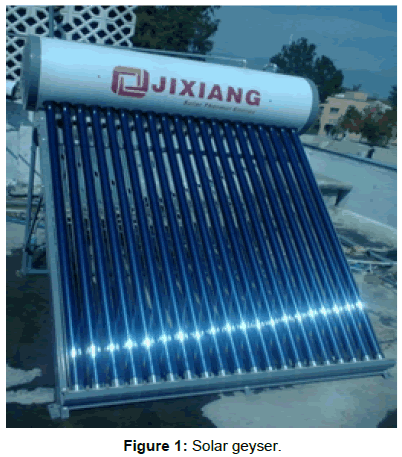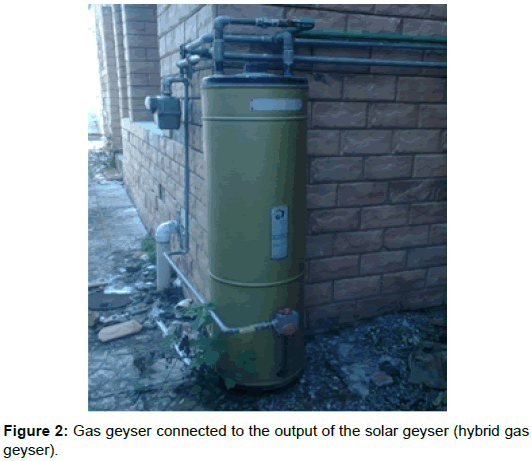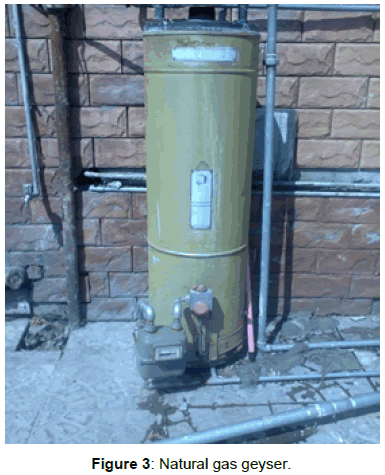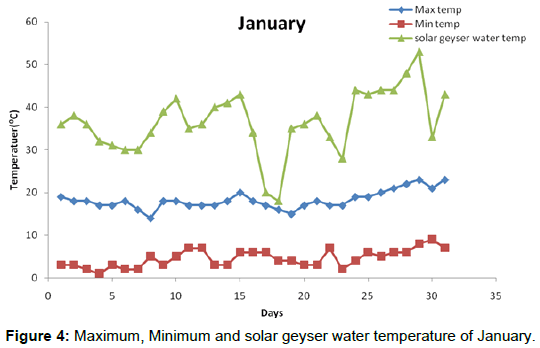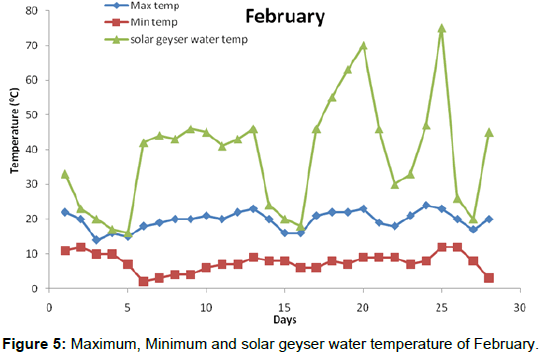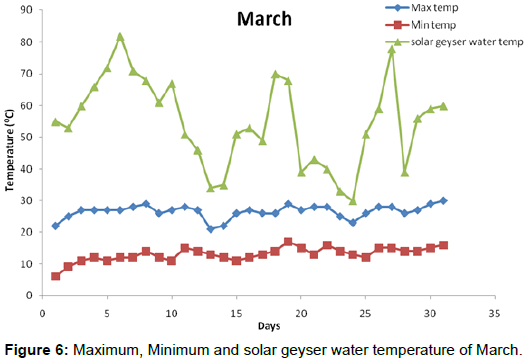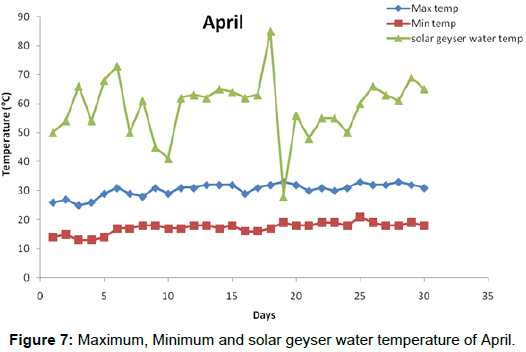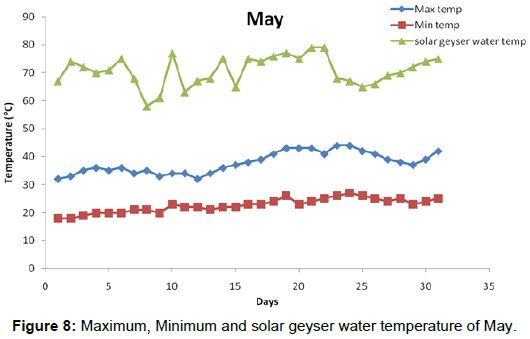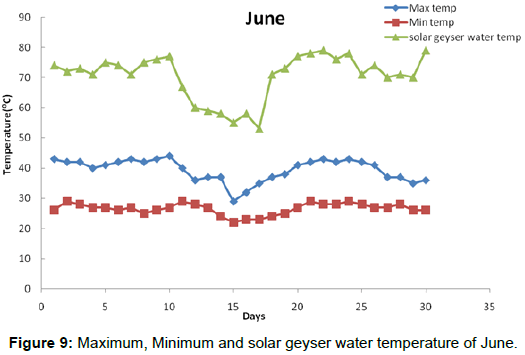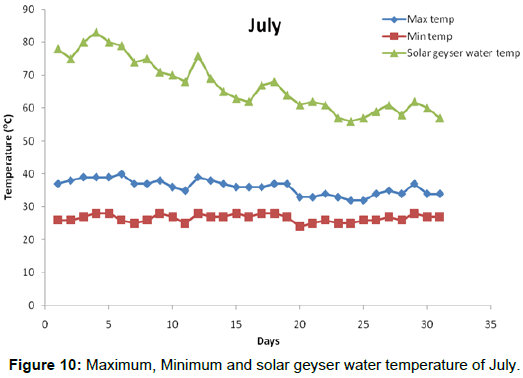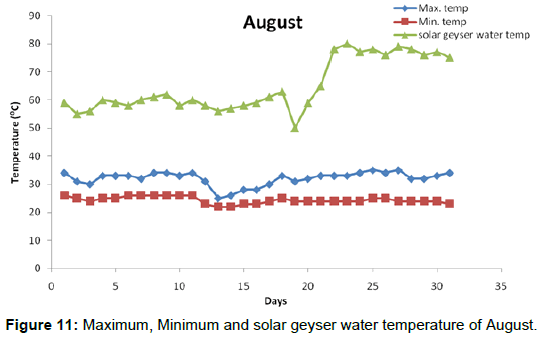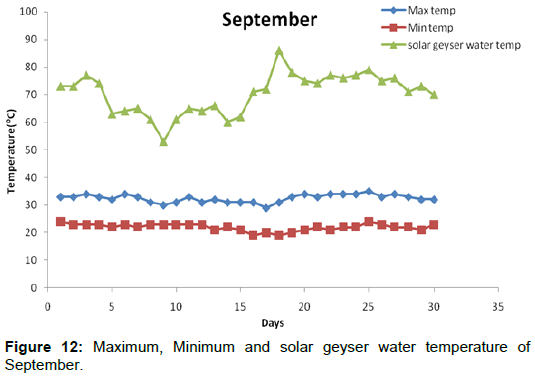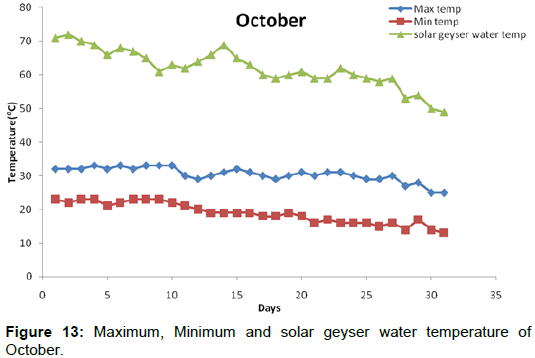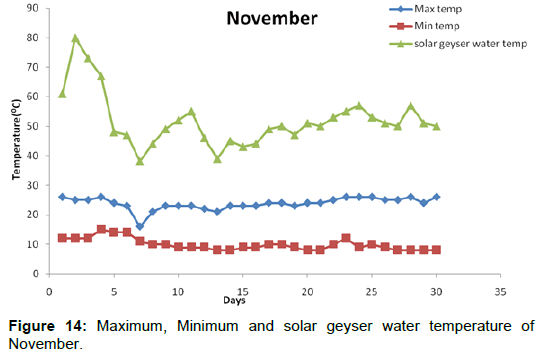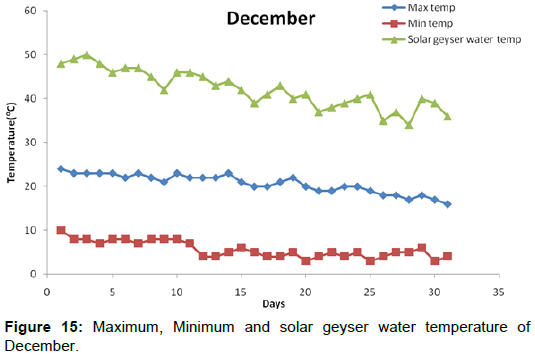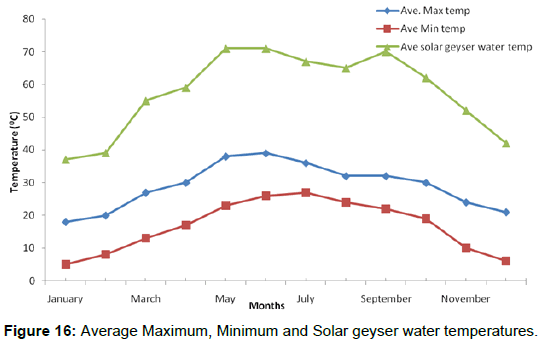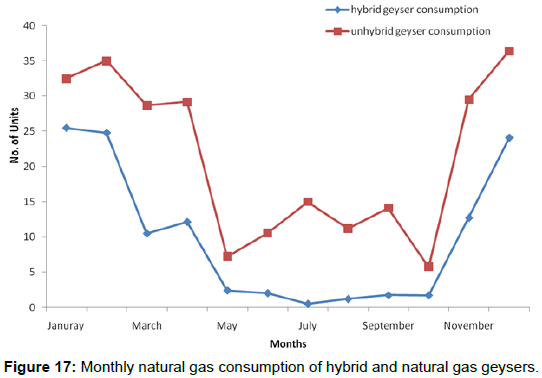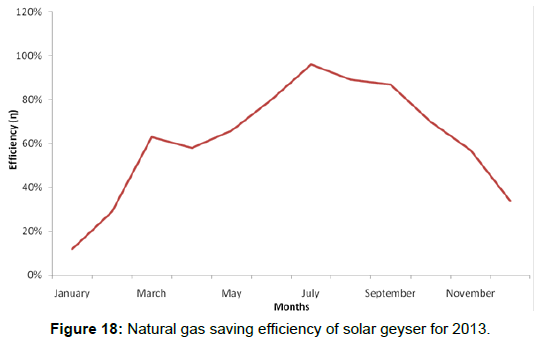Efficiency of a Hybrid Solar Geyser at Allama Iqbal Open University, Islamabad, Pakistan
Received: 18-Apr-2018 / Accepted Date: 02-May-2018 / Published Date: 07-May-2018 DOI: 10.4172/2576-1463.1000201
Abstract
This research is carried out to utilize the opportunities to use the renewable energy i.e. solar energy for the research complex building at Allama Iqbal Open University, Islamabad, Pakistan. The main objective of the research is to save natural gas and utilize solar energy. The two geysers were installed, solar geyser hybrid with the natural gas geyser, another natural gas geyser (N.G) of the same load along with separated gas meter. Data has been collected from both hybrid and natural gas geysers for the period of one year i.e. Jan-Dec, 2013. The gas meter readings are then compared for both hybrid and natural gas geysers. The results show that, the behavior of linear increase and decrease is due to variation of load on the system as well as variation of solar insolation throughout the year. Load is maximum in winter and minimum in summer. The overall monthly average efficiency of the hybrid solar geyser is 62%. We conclude that a single family can save 62% of natural gas per year by using hybrid solar geyser. Furthermore solar geyser is very useful for the country. The Govt of Pakistan needs to aware the people.
Keywords: Geyser; Hybrid geyser; Thermal performance; Efficiency; Save natural gas
Nomenclature
MTOE: Million Tons of Oil Equivalent; km: kilometer; kWh: Kilo Watt Hour; Mt: Million Ton; kt: kilo Ton; GWh: Giga Watt Hour; A: Cross Section of Tube(cm2); PST: Pakistan Standard Time; N1: Number of Gas Units Consumed by Hybrid Gas Geyser; N2: Number of Gas Units Consumed by Natural Gas Geyser; MJm-2: Million Joule Per Meter Square; AEDB: Alternative Energy Development Board.
Introduction
Energy is a natural resource without which long lasting progress and prosperity is not possible. The energy resources can be divided into two main categories. The first category includes all the conventional energy resources i.e. the fossil fuels (coal, petroleum, Natural Gas), and nuclear energy, while the second category comprises the renewable energy resources i.e. wind energy, solar energy, energy of tidal waves and geothermal energy [1]. The renewable energy resources are environment friendly and abundantly available with no carbon dioxide emissions [2]. Conventional energy sources, both the fossil fuels and nuclear energy are dominantly used all over the world. These resources are depleting day by day due to huge consumption all over the world. Coal and petroleum sources will deplete within a time period of 25 and 200 years respectively [1]. Therefore, attention must be diverted towards a cost-effective usage of renewable energy resources.
Pakistan has large potential of renewable energy resources. Wind energy can produce up to 50,000 MW of power (AEDB). Solar insolation is sufficient for the generation of energy up to 1000 Watts per square meter in Pakistan (AEDB). Exploitation of Biomass, tidal and geothermal resources can also contribute towards the solution of energy crisis in Pakistan.
Solar energy is one of the cleanest energy resources that do not increase the global warming. The sun provides more energy in one second than the global energy demand [3]. The sun’s insolation in Pakistan is 5-7 kWh/m2/day which can provide 18-25 MJ/m2 energy per day [4-6]. Solar energy has great future potential but at present it is being used to generate less than 1% of total electricity supply [3]. With the awareness of the people and by adopting latest technology the solar energy can be used for power generation to solve the energy crisis in the country. The total energy requirement in Pakistan is about 62 MTOE. With 10% efficient solar energy converters and an area of 625 km2 energy of 60 MTOE can be generated [4].
There are many applications of solar energy one of which is solar geysers. Solar thermal energy can be utilized directly in the solar geysers. Solar thermal energy collecting systems have an initial cost which is two to five times higher than the alternatives using electricity, LPG, fuel or other solid energy sources. In the long term, the only expense on solar thermal energy collecting system is a routine maintenance cost, while the running cost of alternative systems is much higher due to higher cost of conventional energy [1]. Due to enormous benefits of solar water heating systems, such as the reduction of harmful emissions and in the conservation of non renewable energy fuels for application for which currently no any renewable energy resources available. Solar water heating systems are using all over the world and do not produce greenhouse gas emissions [7]. In Greece 26893 GWh energy has been conserved during 1978 to 2007 by using solar water heating systems, thus reducing the toxic gas emissions by 33.1 Mt CO2, 47.1 kt NOx and 248.7 kt SO2 [8]. Solar water heating systems are mainly using for domestic purposes, because at domestic level water of moderate temperature is required. A compact type solar geyser can supply hot water for 24 hours when its temperature reaches 68°C in the month of July having water tank of 10 cm depth [9]. Solar water heating systems are equally efficient in winter seasons. A natural circulation type solar water heater can provide hot water at an average temperature of 60°C during day time when normal water temperature is 23°C. It can retain hot water till next day morning at an average temperature of 51°C [10]. Solar water heating systems largely depend on the performance and efficiency of the collectors for capturing the solar radiations and transferring the thermal energy to the water. The efficiency of the collectors depends upon the material used in their manufacture. With today’s latest technology solar geysers can provide hot water having temperatures from 60-80°C [11]. Efficiency of the solar geyser increases linearly with the increase in temperature. Solar energy can be utilize for water heating by using flat plate solar collectors or evacuated tube solar collectors. Evacuated tube solar collectors have better performance than flat-plate solar collectors [5,12], in particular for high temperature operations [13]. The performance also depends upon climatic and operational conditions.
In this paper testing of the performance of a hybrid solar geyser has been described. The study was carried out for the research complex building at Allama Iqbal Open University, Islamabad, Pakistan. A solar geyser has been hybridized with a gas geyser. Data (N1) will be collected for the hybrid and (N2) for the natural gas geyser in the form of gas meter readings. Then efficiency of the solar geyser will be determined for a period of one year and the saving of natural gas and cost will be calculated.
Design
The solar geyser consists of 20 evacuated tubes and a storage tank of 200 liters capacity as shown in the Figure 1. The length of the tubes is 180 cm and the diameter is about 5 cm, therefore the cross section ‘A’ of the tubes is equal to 19.64 cm2 and the volume of water in each tube is 3535.2 cm3. The geyser is facing south and having an angle of approximately 45° from the horizontal to receive the maximum solar radiations during the day. Water was supplied to both the geyser systems from the main storage tank. The output of the solar geyser has been connected to the input of a gas geyser to achieve the hybridization, as shown in the Figure 2.
A natural gas geyser with the same load and having a separate gas meter was also installed in the same building so as to compare the gas consumption in both the systems (Figure 3).
Data is being collected twice a day for both the systems for the period of one year i.e. Jan-Dec, 2013. The temperature of the water in both systems is also being checked daily at 16:00 hours. Water level in the main storage tank is maintained for uninterrupted supply to the experimental systems.
Performance and Data
There are three geysers involved in this project. Two of which are gas geysers and one is solar geyser. The load on the gas geysers is approximately same. Both are installed in the research complex building. To check the consumption of both the natural gas geysers, separate gas meters are installed on both. One of the gas geysers forms the hybrid system with the solar geyser in such a way that the output of the solar geyser is connected to the input of the gas geyser. Both the gas geysers have automatic thermo switch which automatically switch the burners on or off to maintain constant water temperature.
Data has been collected in the form of gas meter readings, daily minimum, maximum and solar geyser water temperatures. Temperature of water in solar geyser storage tank and the gas meter readings for both geyser systems were taken daily at 0900 and 1600 h. The day to day variation of minimum, maximum and the solar geyser water temperatures are shown graphically in Figures 4-15 giving a comparison for the whole year.
Average Temperatures
The average daily maximum, minimum and solar geyser water temperatures for the whole year 2013 are given in Table 1.
| S.No | Months | Minimum Temperature | Maximum Temperature | Solar geyser water temperature |
|---|---|---|---|---|
| 1 | January | 5 | 18 | 37 |
| 2 | February | 8 | 20 | 39 |
| 3 | March | 13 | 27 | 55 |
| 4 | April | 17 | 30 | 59 |
| 5 | May | 23 | 38 | 71 |
| 6 | June | 26 | 39 | 71 |
| 7 | July | 27 | 36 | 67 |
| 8 | August | 24 | 32 | 65 |
| 9 | September | 22 | 32 | 70 |
| 10 | October | 19 | 30 | 62 |
| 11 | November | 10 | 24 | 52 |
| 12 | December | 6 | 21 | 42 |
Table 1: Average Maximum, Minimum and Solar Geyser Water Temperatures.
The graphical presentation of the above average temperatures is as shown in Figure 16. The peak values of average maximum, minimum and solar geyser water temperatures are 39°C, 27°C and 71°C in the months of June and July. Figure 16 clearly shows that average temperatures are maximum in June and July and minimum in December and January.
Monthly Natural Gas Consumption
Monthly natural gas consumption of hybrid and natural gas geysers is given in Table 2 for the year 2013. Gas meters measure natural gas consumption in volume i.e. m3.
| S.No | Months | Consumption of Hybrid Gas Geyser (m3) | Consumption of Natural Gas Geyser (m3) |
|---|---|---|---|
| 1 | January | 25.508 | 32.48 |
| 2 | February | 24.814 | 35.005 |
| 3 | March | 10.527 | 28.696 |
| 4 | April | 12.159 | 29.199 |
| 5 | May | 2.434 | 7.217 |
| 6 | June | 2.056 | 10.552 |
| 7 | July | 0.534 | 15.001 |
| 8 | August | 1.225 | 11.17 |
| 9 | September | 1.753 | 14.111 |
| 10 | October | 1.744 | 5.724 |
| 11 | November | 12.751 | 29.537 |
| 12 | December | 24.107 | 36.436 |
Table 2: Monthly Natural Gas Consumption of Hybrid and Natural Gas Geyser.
The graphical behavior for the consumption of both geysers is shown in Figure 17 for the year 2013. Total natural gas consumption of natural gas geyser is 516.017 m3 and for hybrid it is 358.769 m3.
It can be seen from this figure that the consumption of hybrid gas geyser is less than natural gas geyser in each month throughout the year. Comparison of Figures 16 and 17 shows that average maximum, minimum, solar geyser water temperatures and monthly natural gas consumptions have inverse behaviour increase in temperatures decrease consumption of natural gas. The graphical behaviour shows that hybridization is useful throughout the year in the saving of natural gas.
Natural Gas Saving Efficiency of Solar Geyser
The natural gas saving efficiency of the solar geyser can be calculated using the formula:

N1 and N2 are the total number of gas units in m3 consumed each month throughout the year by the hybrid and natural gas geysers respectively. Corresponding efficiencies η are also shown for each month Table 3.
| S.No | Months | Consumption of Hybrid Gas Geyser (m3) | Consumption of Natural Gas Geyser (m3) | Efficiency (η) |
|---|---|---|---|---|
| 1 | January | 25.508 | 32.48 | 12% |
| 2 | February | 24.814 | 35.005 | 29% |
| 3 | March | 10.527 | 28.696 | 63% |
| 4 | April | 12.159 | 29.199 | 58% |
| 5 | May | 2.434 | 7.217 | 66% |
| 6 | June | 2.056 | 10.552 | 80% |
| 7 | July | 0.534 | 15.001 | 96% |
| 8 | August | 1.225 | 11.17 | 89% |
| 9 | September | 1.753 | 14.111 | 87% |
| 10 | October | 1.744 | 5.724 | 70% |
| 11 | November | 12.751 | 29.537 | 57% |
| 12 | December | 24.107 | 36.436 | 34% |
Table 3: Efficiency of Hybrid Solar Geyser for 2013.
The efficiency is maximum in summer and minimum in winter due rainy and cloudy weather. The solar insolation and load also vary in these seasons. Solar insolation has maximum values in summer and minimum in winter and load is maximum in winter and minimum in summer Figure 18 shows this behavior.
From this graph it is clear that efficiency of solar geyser is almost directly proportional to the solar insolation. The maximum efficiency was in the month of July which is 96%. The calculated monthly average efficiency is 62%. The total natural gas consumed by the hybrid geyser is 358.769 m3 and the total natural gas consumption of natural gas geyser is 516.017 m3 shows saving of about 157.248 m3 of natural gas throughout the year.
Conclusion
We concluded from data that using a solar geyser in tandem with a natural gas geyser can significantly reduce the natural gas bill/cost. The results show increase in the average efficiency of solar geyser in summer, autumn and spring having values of 88%, 71% and 62% respectively. The overall monthly average efficiency of the solar geyser for the year 2013 is 62%. Solar geyser due to hybridization has saved about 157.248 m3 of natural gas throughout the year. It means that a single family can save 62% of natural gas per year; which will help in load shedding and save the reserves of natural gas.
Acknowledgment
I would like to offer my sincerest compliments to my supervisor Prof. Dr. Syed Zafar Ilyas for their patience, guidance, motivation, immense knowledge and encouragement for the completion of this research work. I am thankful to Vice Chancellor, Allama Iqbal Open University, Islamabad for the financial support to complete this project. I am also grateful and acknowledge the services of all the faculty members and staff of the Department of Physics AIOU, Islamabad for their encouragement, support and guidance; without which completion of this work was impossible.
References
- Ozsabuncuoglu IH (1995) Economic analysis of flat plate collectors of solar energy. Energy Policy 23: 755-763.
- Bhutto AW, Karim S (2007) Energy-poverty alleviation in Pakistan through use of indigenous energy resources. Energy for Sustainable Development 11: 58-67.
- Sheikh MA (2009) Renewable energy resource potential in Pakistan. Renewable and Sustainable Energy Reviews 13: 2696-2702.
- Solangi KH, Islam MR, Saidur R, Rahim NA, Fayaz H (2011) A review on global solar energy policy. Renewable and Sustainable Energy Reviews 15: 2149-2163.
- Mohsen MS, Ghandoor AA, Al-Hinti I (2009) Thermal analysis of compact solar water heater under local climatic conditions. International Communications in Heat and Mass Transfer 36: 962-968.
- Tsilingiridis G, Martinopoulos G (2010) Thirty years of domestic solar hot water systems use in Greece, energy and environmental Benefits, future perspectives. Renewable Energy 35: 490-497.
- Nahar NM (2003) Year round performance and potential of a natural circulation type of solar water heater in India. Energy and Buildings 35: 239-247.
- Veeraboina P, Ratnam GY (2012) Analysis of the opportunities and challenges of Solar Water Heating System (SWHS) in India: Estimates from the energy audit surveys & review. Renewable and Sustainable Energy Reviews 16: 668-676.
- Durrani A, Nasir SM, Ilyas SZ (1994) Solar insolation at Quetta, Pakistan. Journal of Mehran University of Engineering & Technology pp: 20-24.
- Ilyas SZ, Nasir SM, Badshah T (2004) The Theoretical Analysis for a Flat Plate Collector. Journal of Applied and Emerging Science 1: 198-208.
- Ilyas SZ, Anwar M, Nasir SM (2000) Cumulative Frequency Distribution of Solar Insolation at Quetta, Pakistan. Renewable Energy 20: 83-86.
- Purohit P, Michaelowa A (2008) Clean Development Mechanism potential of solar water heating systems in India. Solar Energy 82: 799-811.
- Morrison GL, Budihardjo I, Behnia M (2004) Water-in-glass evacuated tube solar water heaters. Solar Energy 76: 135-140.
Citation: Ahmed H, Ilyas SZ (2018) Efficiency of a Hybrid Solar Geyser at Allama Iqbal Open University, Islamabad, Pakistan. Innov Ener Res 7: 201. DOI: 10.4172/2576-1463.1000201
Copyright: © 2018 Ahmed H, et al. This is an open-access article distributed under the terms of the Creative Commons Attribution License, which permits unrestricted use, distribution, and reproduction in any medium, provided the original author and source are credited.
Select your language of interest to view the total content in your interested language
Share This Article
Recommended Journals
Open Access Journals
Article Tools
Article Usage
- Total views: 7143
- [From(publication date): 0-2018 - Nov 30, 2025]
- Breakdown by view type
- HTML page views: 6200
- PDF downloads: 943

